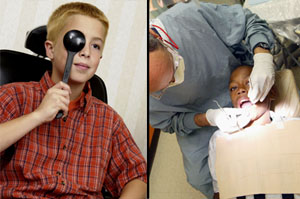One part of the Affordable Care Act is intended to improve dental coverage for children, an extension of efforts by public health advocates that followed the 2007 death of a Maryland boy named Deamonte Driver, who was killed by a bacterial infection that spread from an abscessed tooth to his brain.
The 12-year-old’s family was uninsured, and the family had lost its Medicaid coverage. His mother focused on getting his brother’s six rotting teeth taken care of before turning to Deamonte’s dental care, but by then the infection had spread. After two surgeries and weeks of hospital care, he died.
Supporters of better dental care for children fought to have dental and vision services for children included as part of pediatric services, one of 10 categories of essential benefits.
With the Affordable Care Act, more Americans will have the opportunity to purchase dental insurance on the new health care exchanges starting Oct. 1.
Here are some basic questions and answers about dental and vision coverage.
Q. Will I be required to buy pediatric dental care if I purchase insurance on the exchange?
A. Most likely, no. Children’s dental care may be included in some plans offered on the marketplaces as part of the medical coverage you are required to buy. But many insurers may offer it as a stand-alone policy, which you are not required to buy under federal law but may be required by states. At least two — Nevada and Washington — are requiring this coverage. For children the insurance will help pay for the cost of visits to a dentist for basic or preventive services, like teeth cleaning, X-rays and fillings and medically necessary orthodontics.
Q. Will I be required to buy pediatric vision coverage by the Affordable Care Act?
A. Yes, it will be included in the Medical plan, and at least partially covers vision care, like eye exams and glasses.
Q. Are adults required to get dental coverage?
A. No, but insurers may offer stand-alone dental policies for adults and families. These will not be subsidized, however.
Q. Is it common for health insurers to not offer dental care as part of comprehensive health insurance?
A. Overwhelmingly, dental benefits are contracted and sold separately from medical plans in the current market. The National Association of Dental Plans says 99 percent of dental benefits are sold under a policy that is separate from medical coverage, according to its July 2013 ACA and Dental Coverage report.
Q. How likely are buyers to add stand-alone dental coverage for children to their purchase of a medical policy?
A. It’s hard to say how it will play out. Consumers will be looking for dental plans that best meet their own needs and those of their children at the right price. If purchased from a federally run exchange as a stand-alone policy, pediatric dental care can include out-of-pocket expenses as high as $700 per child or $1,400 per family, according to Colin Reusch, a senior policy analyst with the Children’s Dental Health Project. And the cost of stand-alone coverage won’t count toward the medical out-of-pocket limit built into the health care insurance policy, nor will the premium tax credits families receive to help them purchase coverage always be calculated to include premiums for stand-alone plans. Those costs may cause families to go without coverage, advocates fear.
However, the Delta Dental Plans Association notes that stand-alone dental plans are likely to have much lower deductibles than medical plans that also include child dental care, or possibly no deductibles. They will also have a lower limit on out-of-pocket expenses than plans that combine medical and pediatric dental care. That might benefit many families, particularly those that include children with acute dental care needs or those who want paid preventive care without waiting to spend enough to meet a higher deductible.
Q. How many children may benefit from expanded coverage?
A. Approximately 8.7 million children are expected to gain some form of dental benefits by 2018 as a result of the ACA. This will reduce the number of children without dental benefits by about 55 percent compared with 2010, according to a report from the American Dental Association. About a third of these children will be covered through their parents’ employer-sponsored insurance, while about another third will be covered through Medicaid. The remainder will be covered by new policies from the health insurance exchanges.
This story was modified Oct. 24 to make clear that in some circumstances premiums on stand-alone dental coverage would be counted in calculating the premium tax credits families receive.







